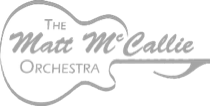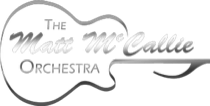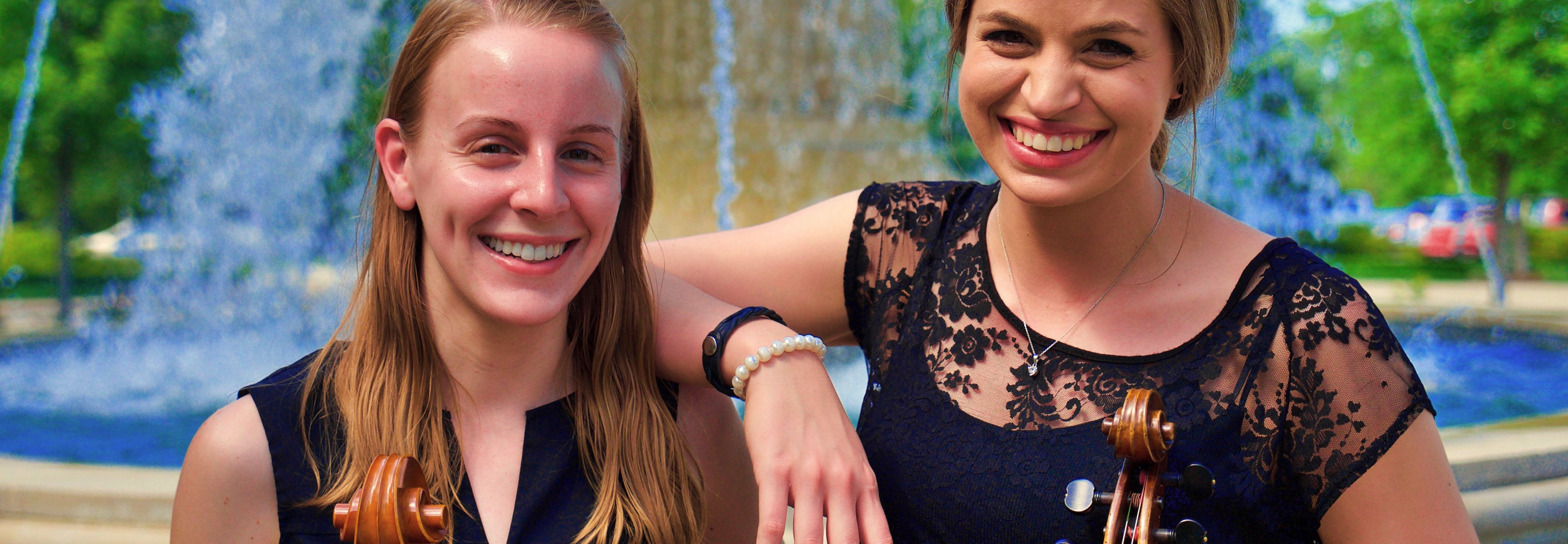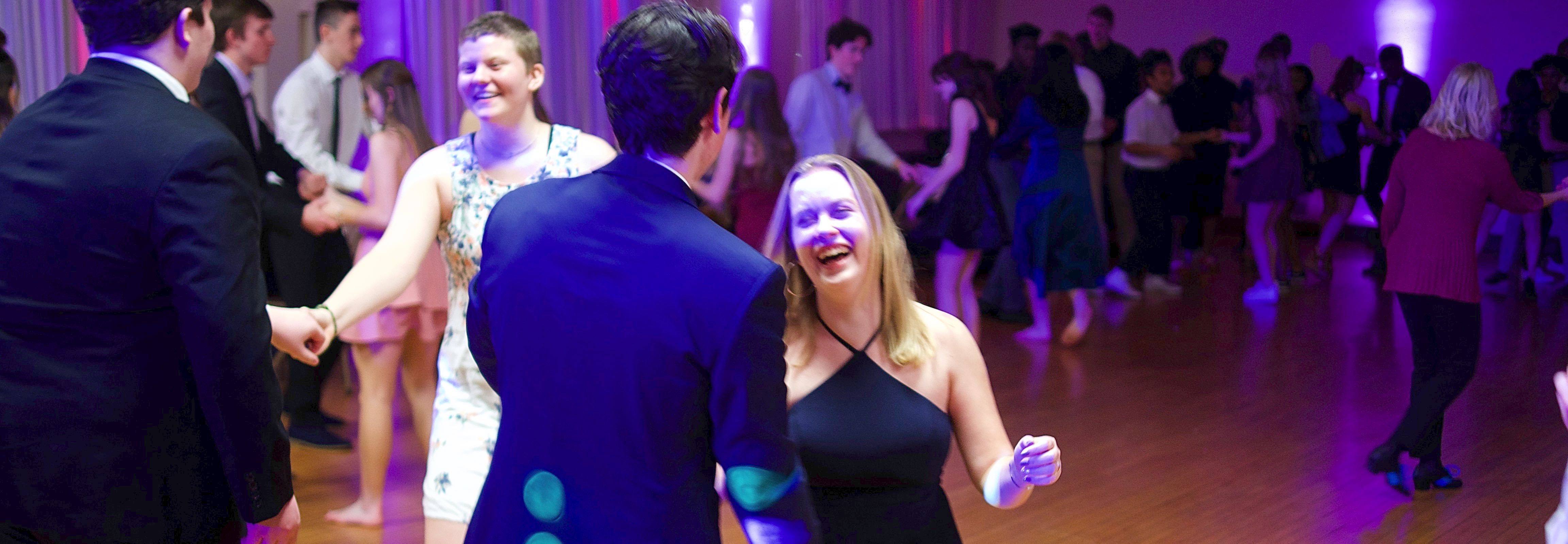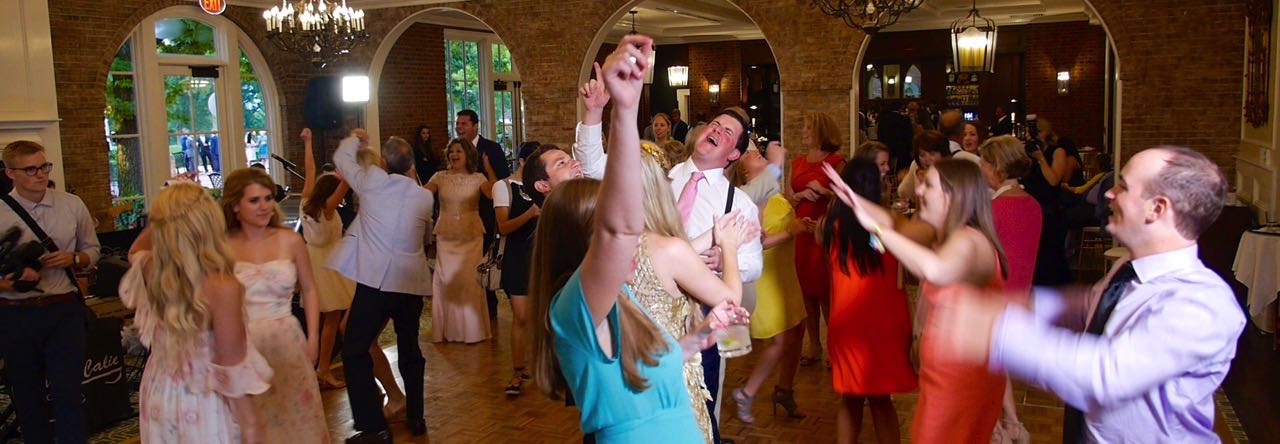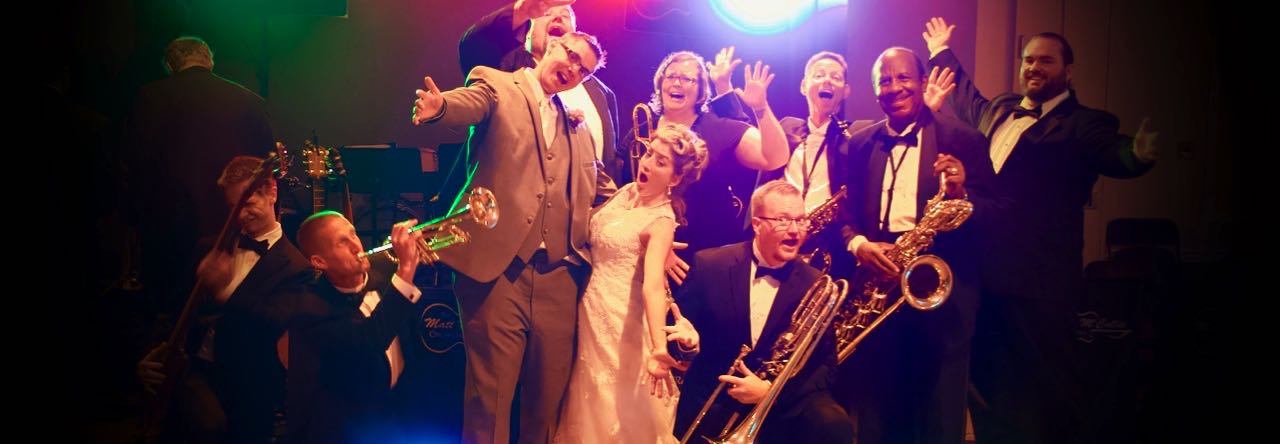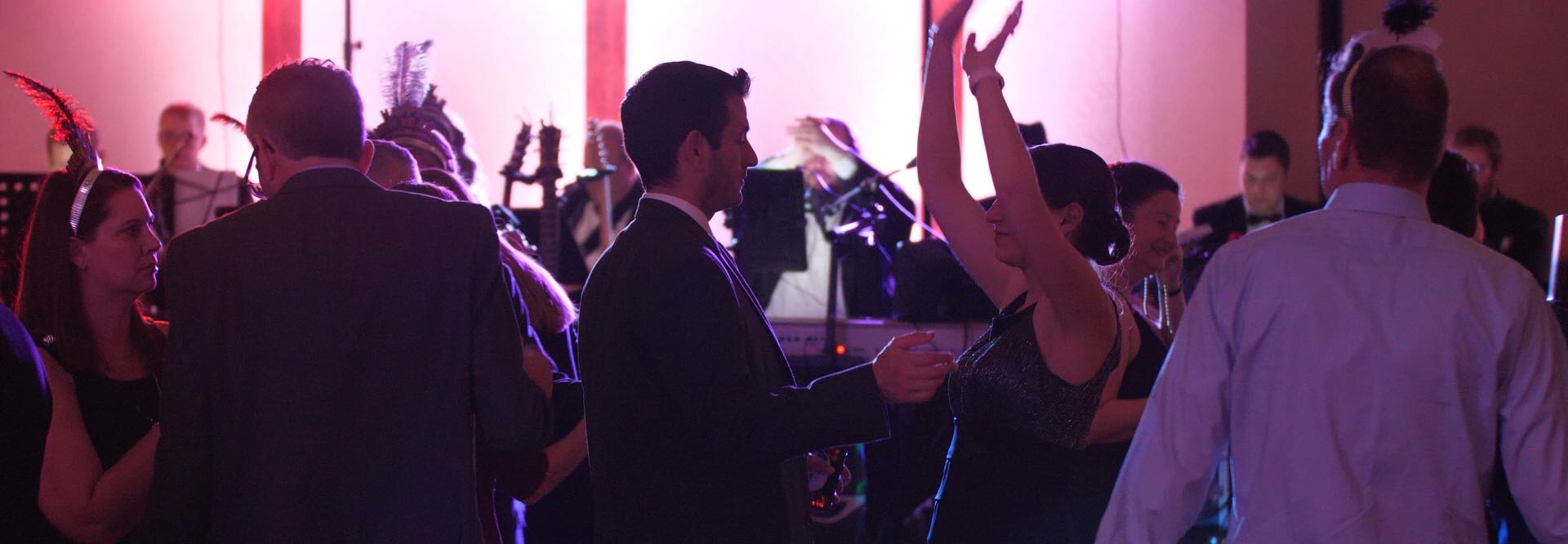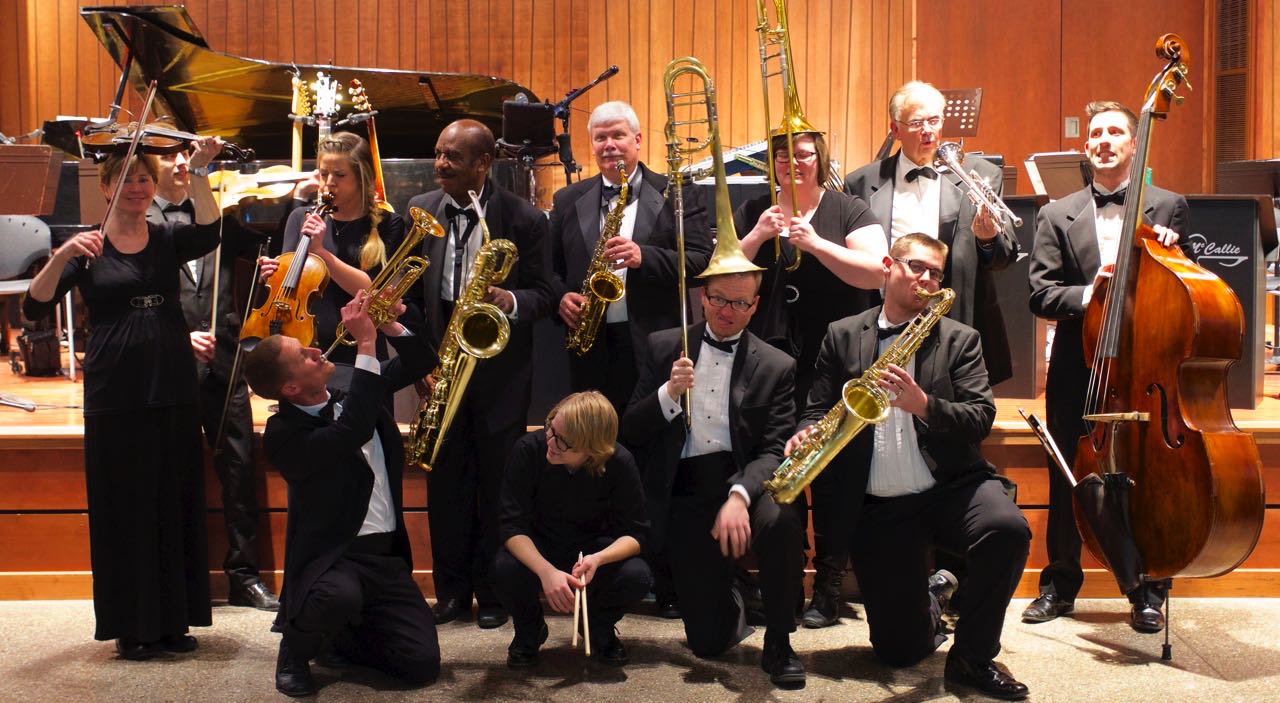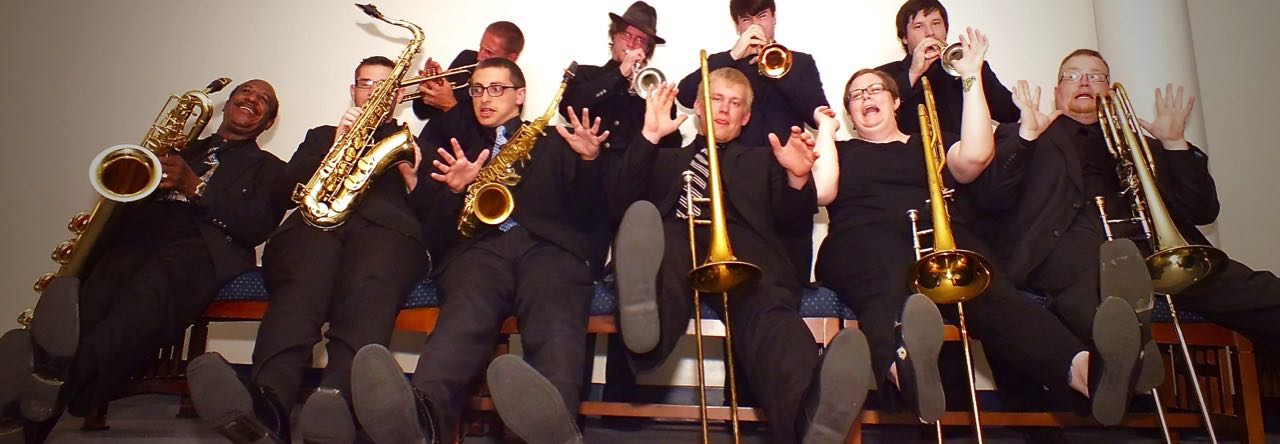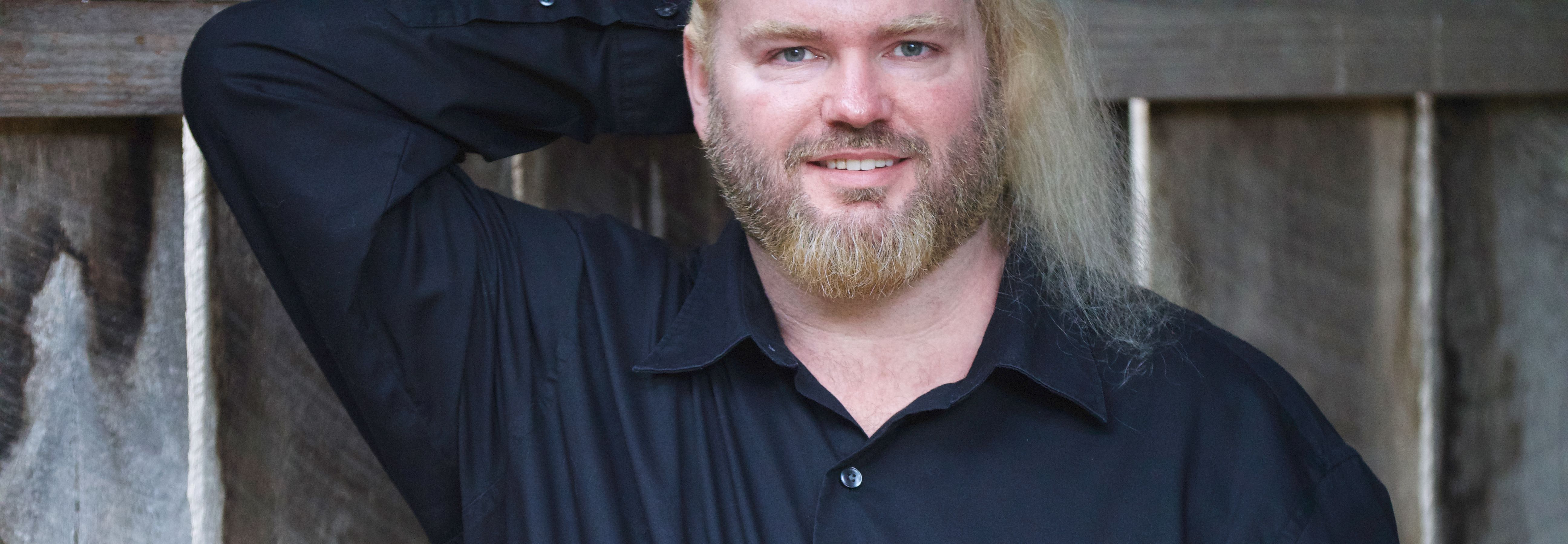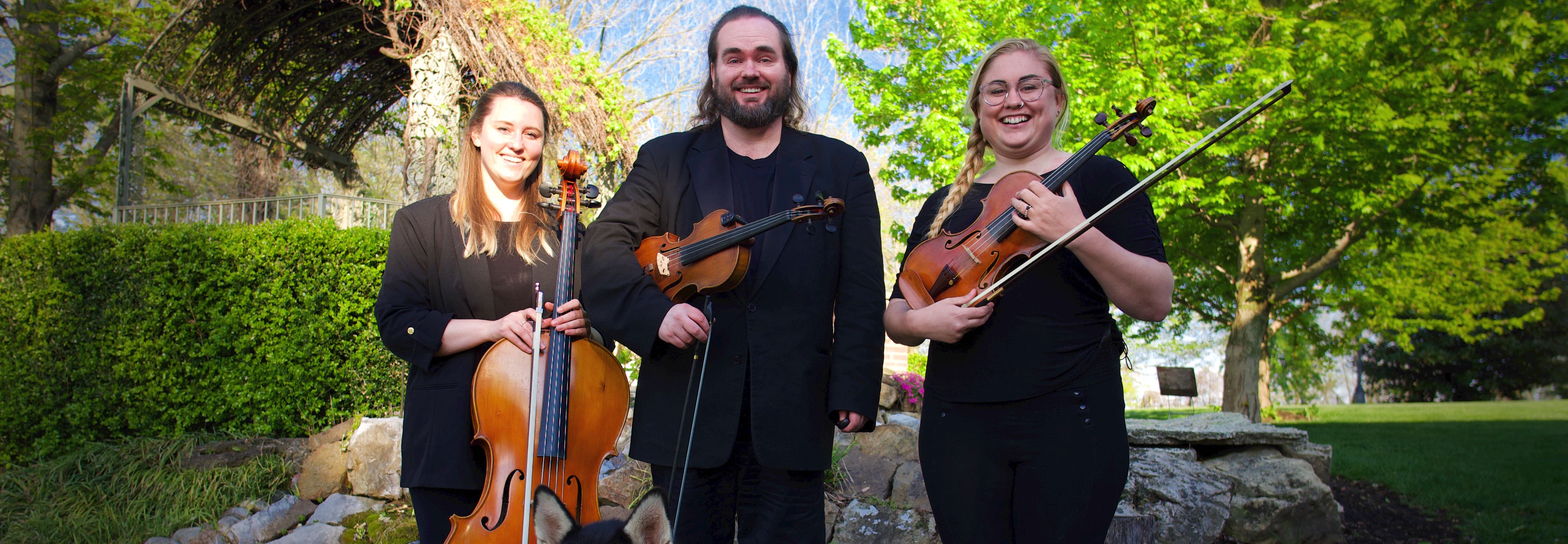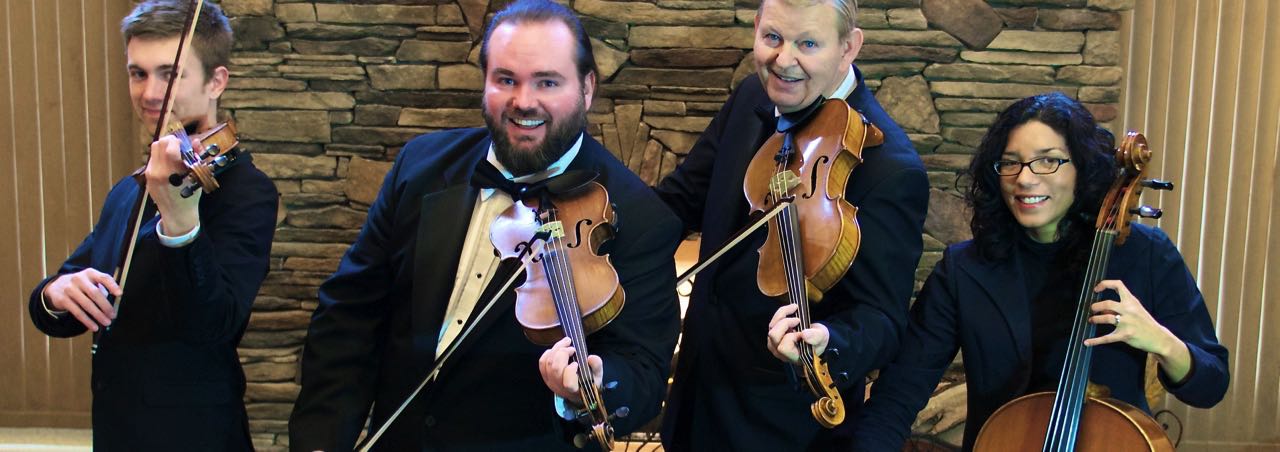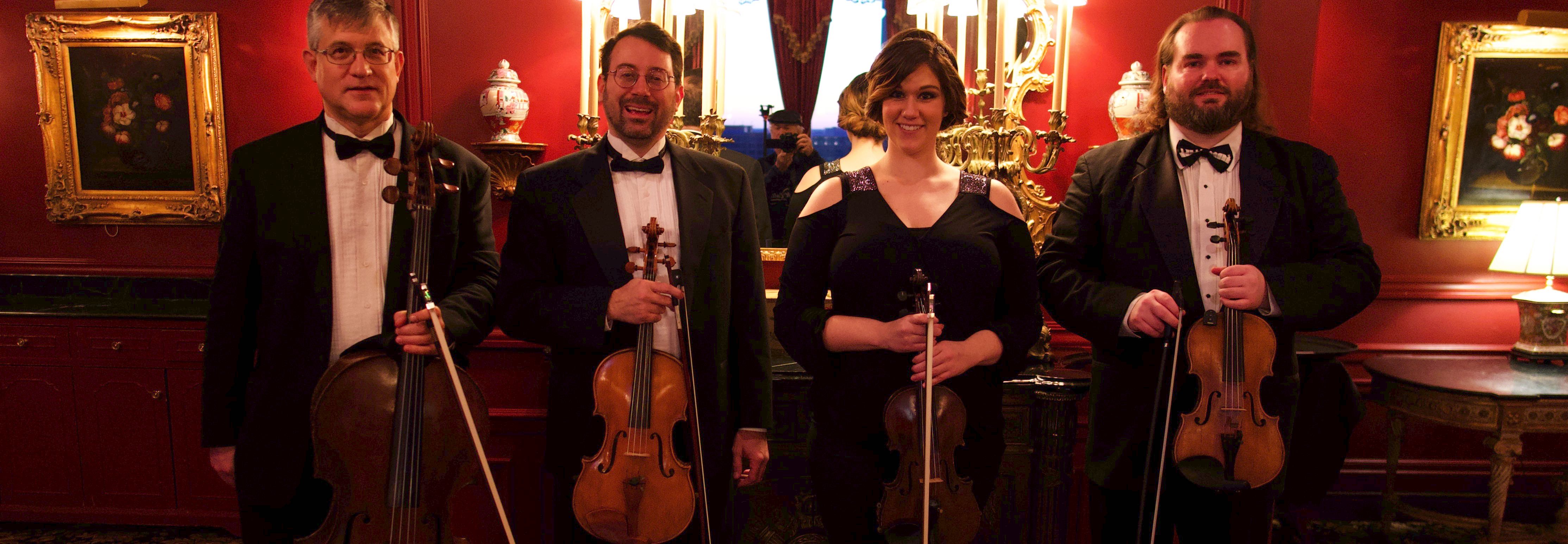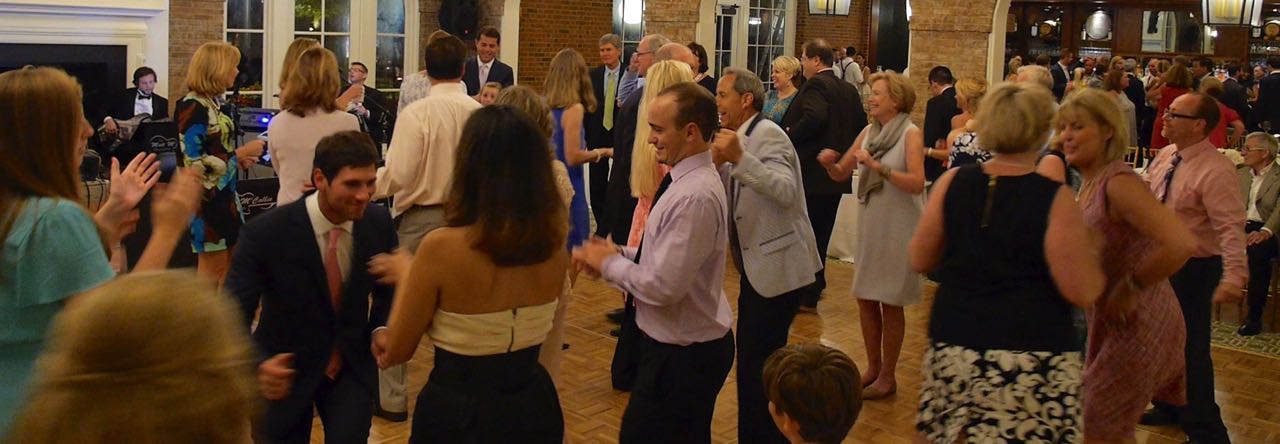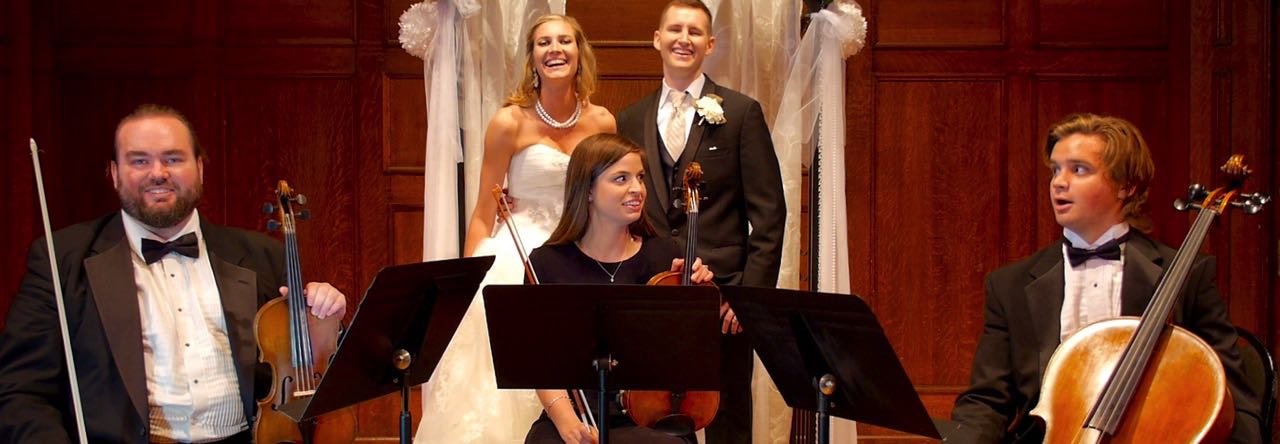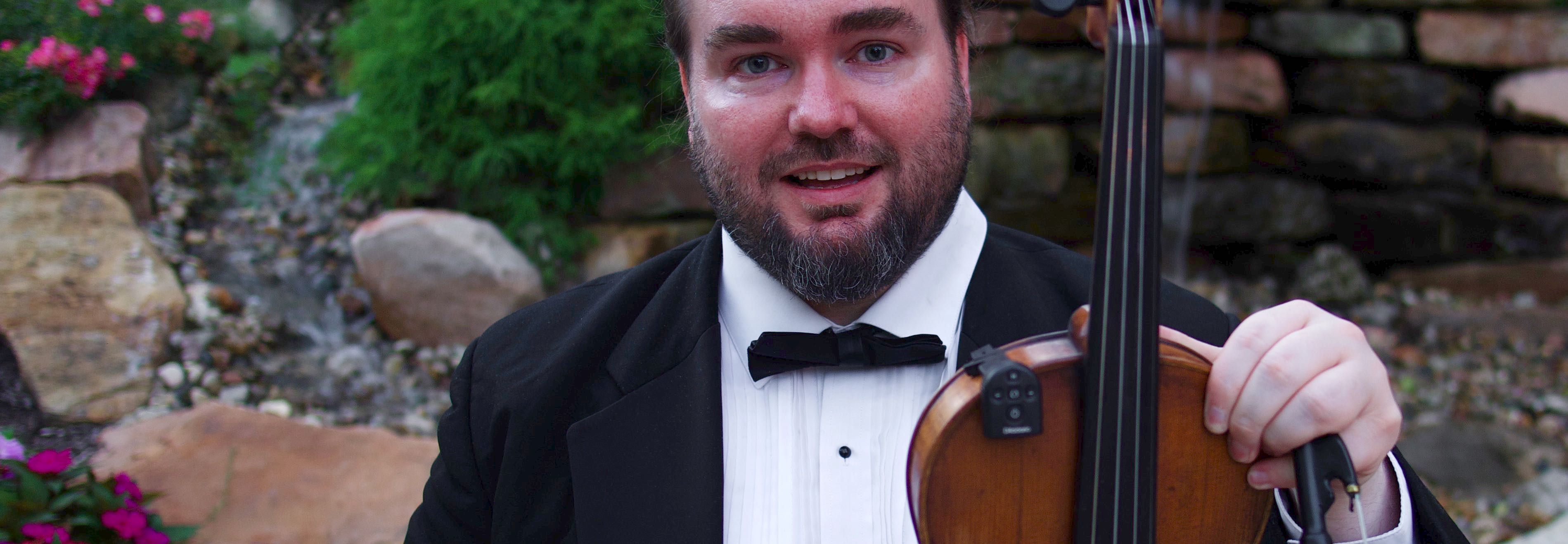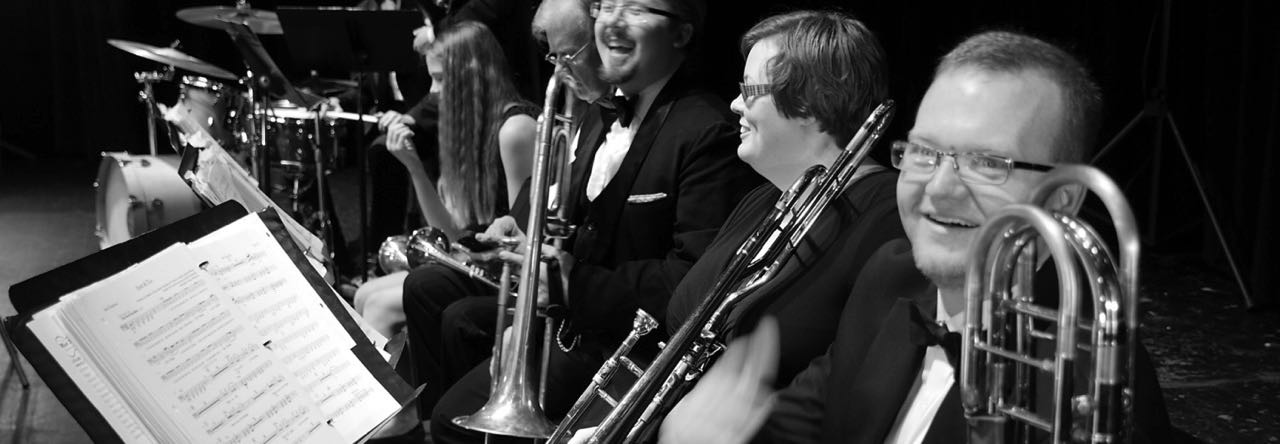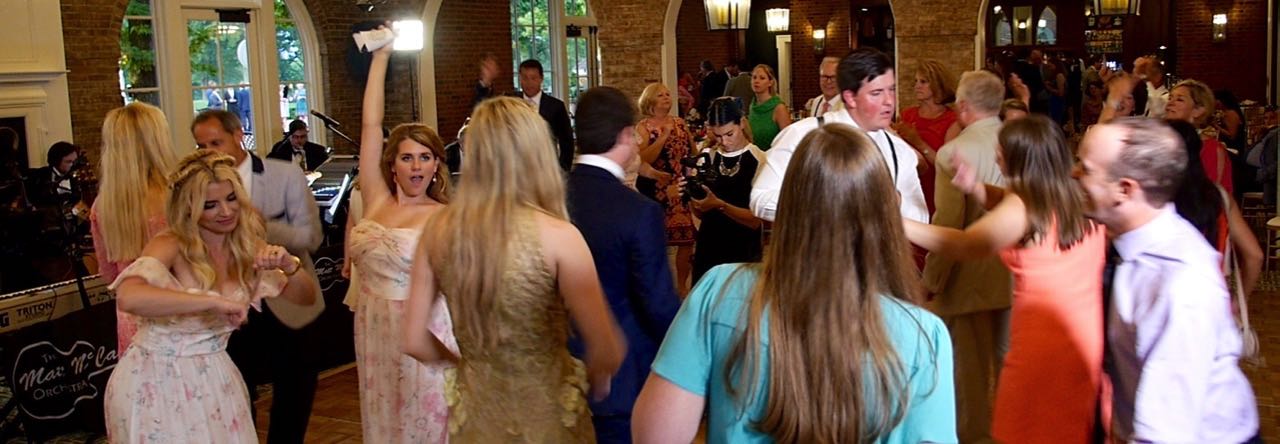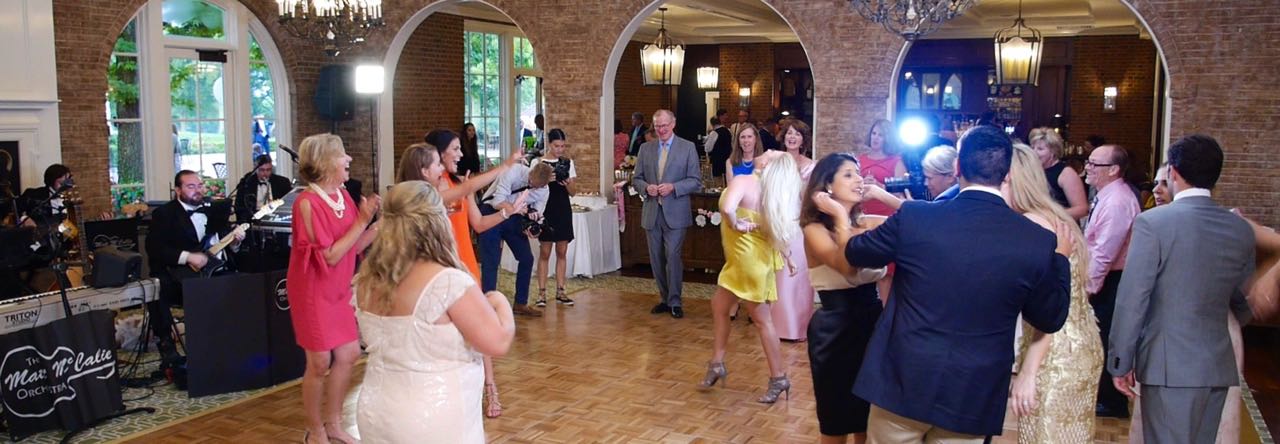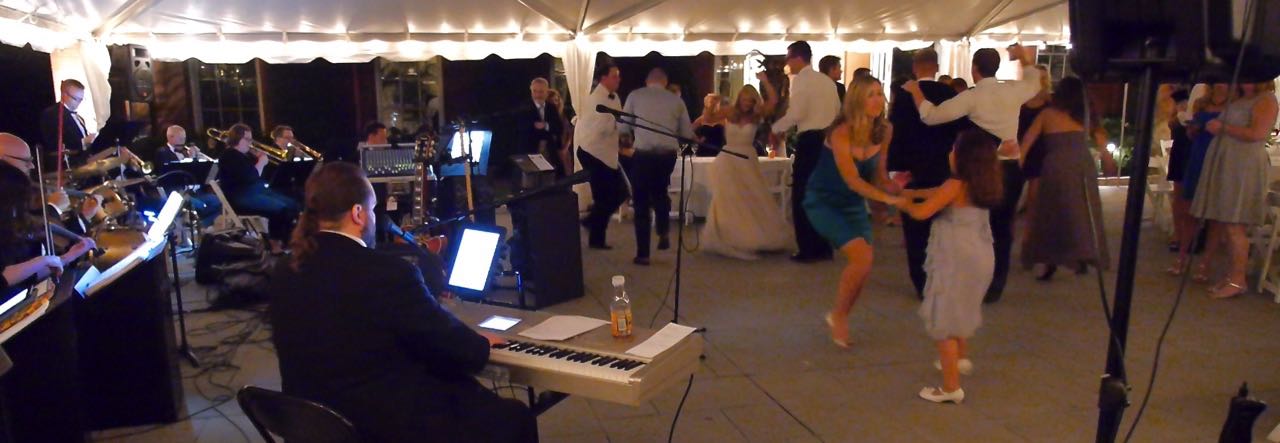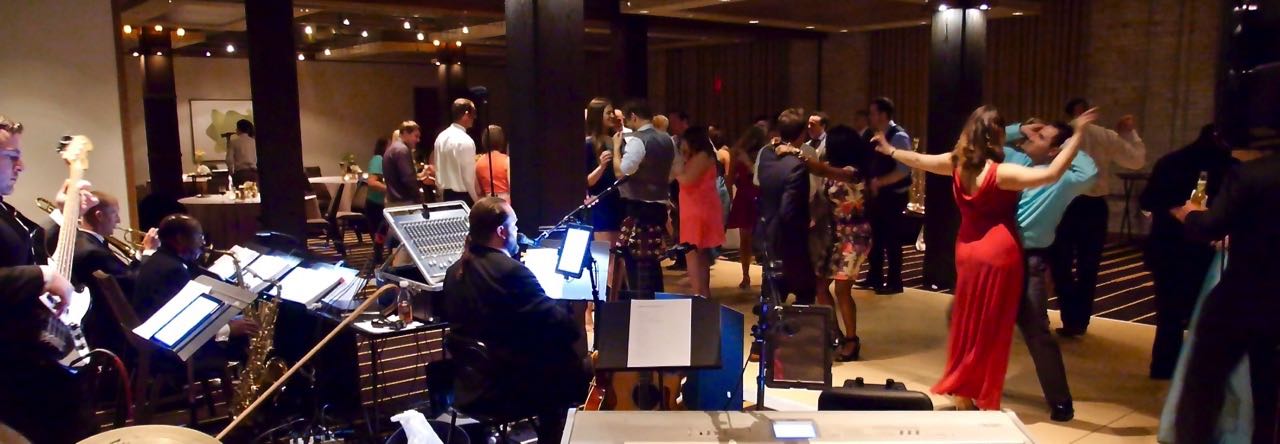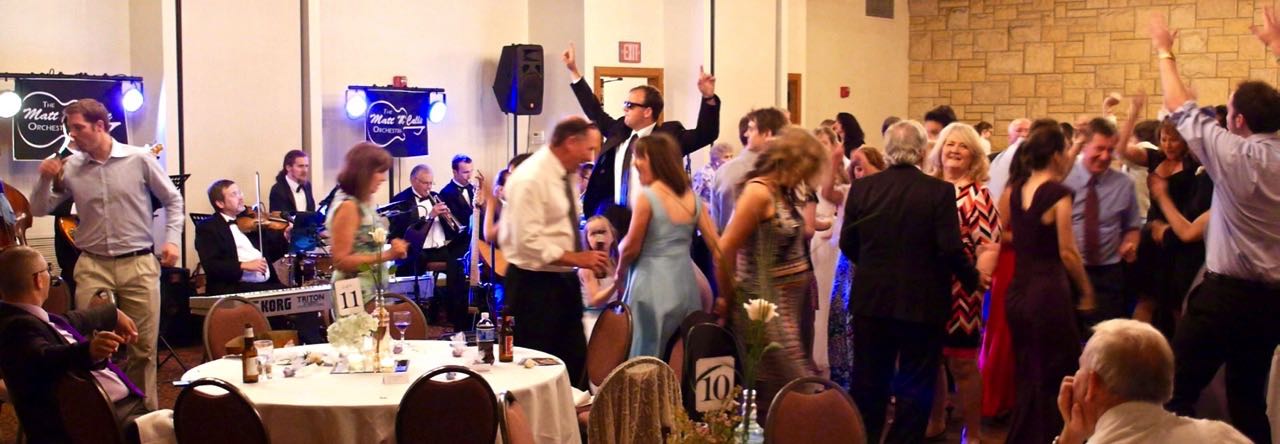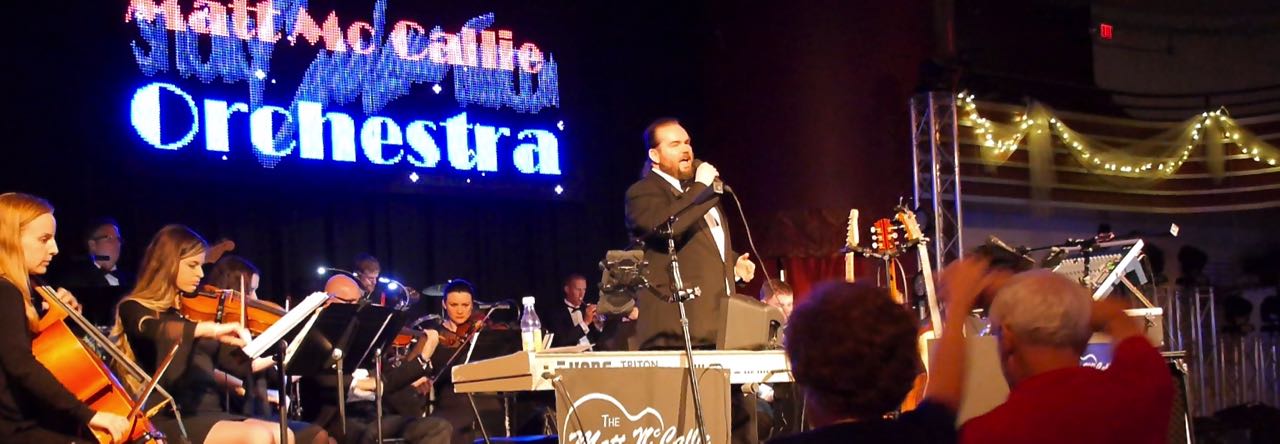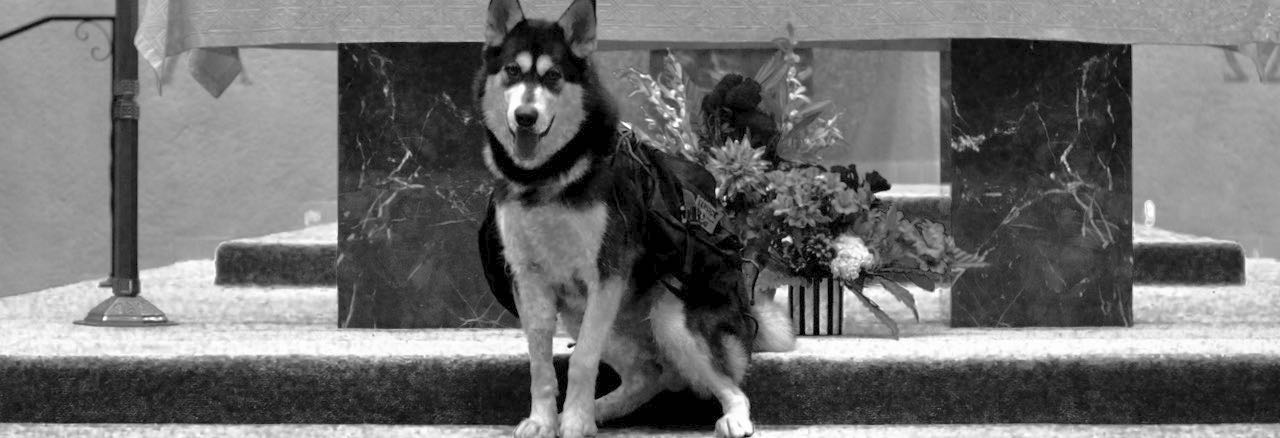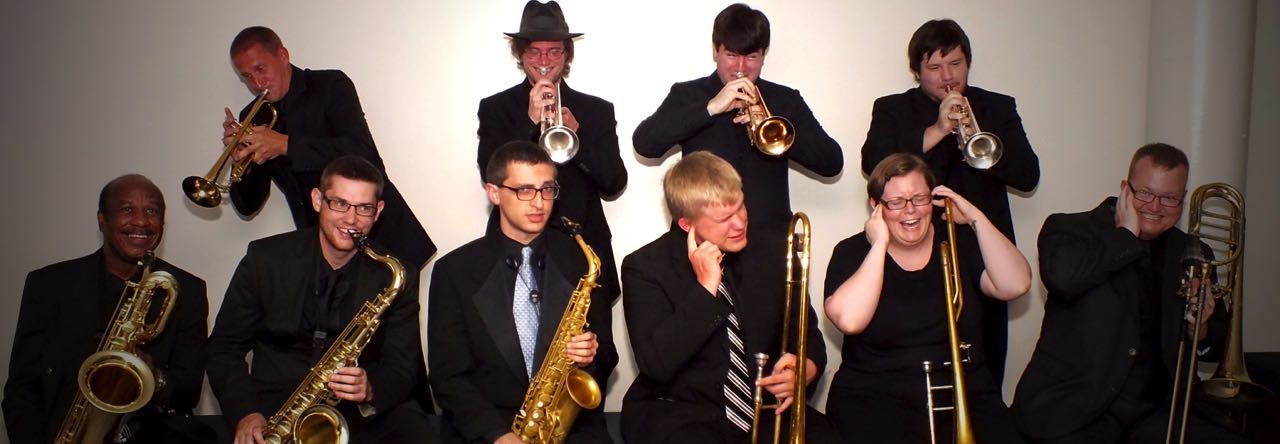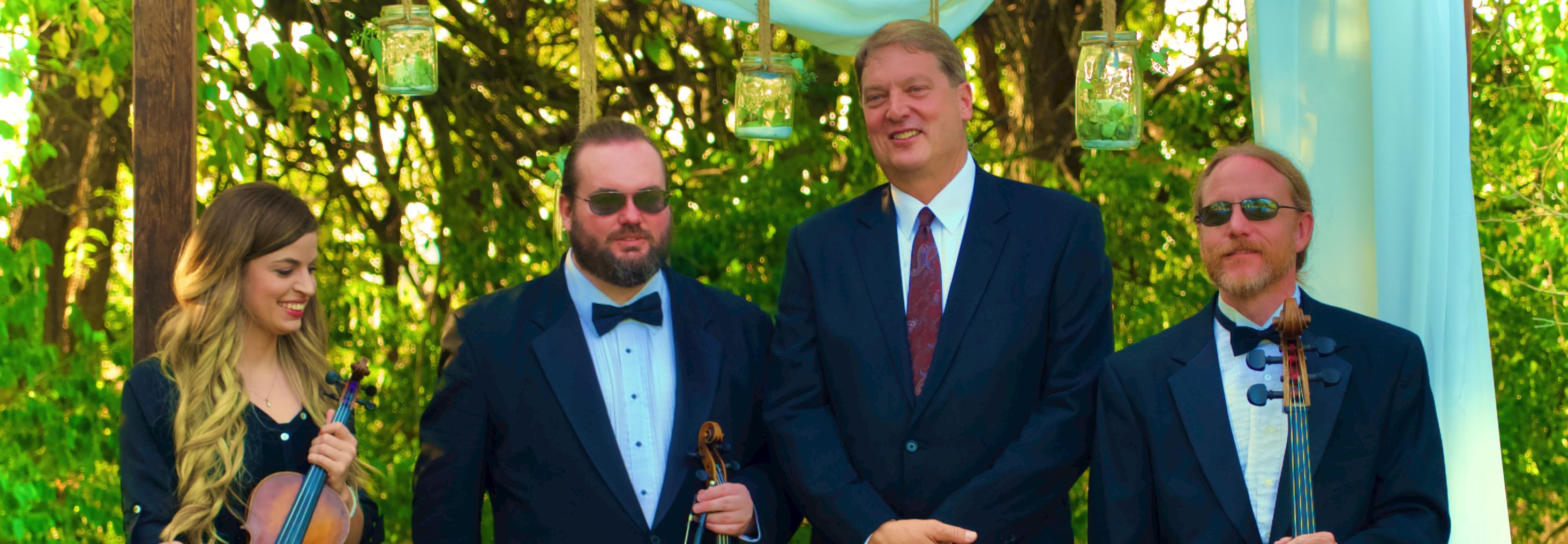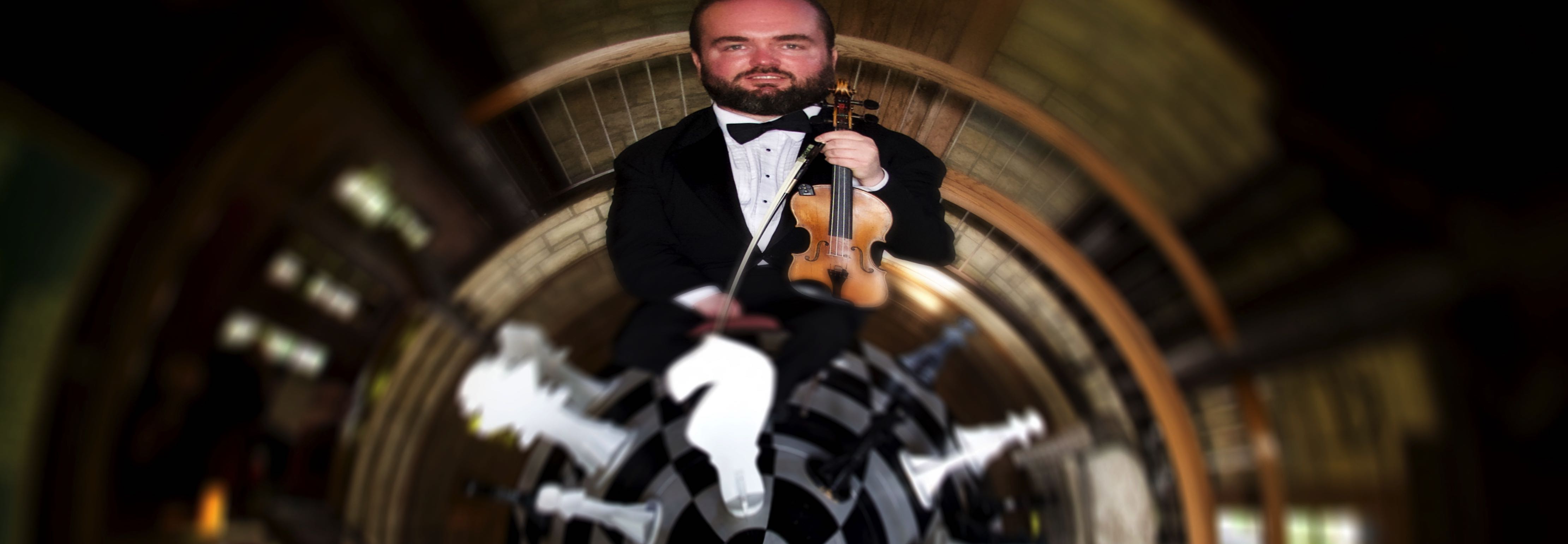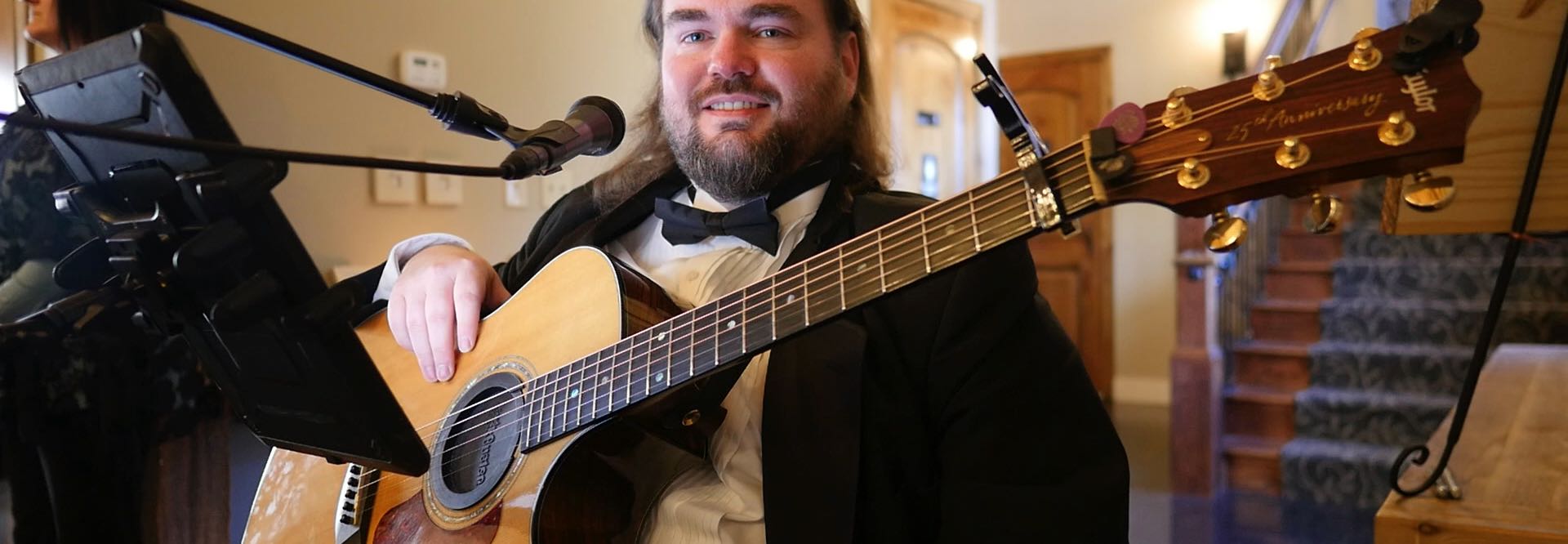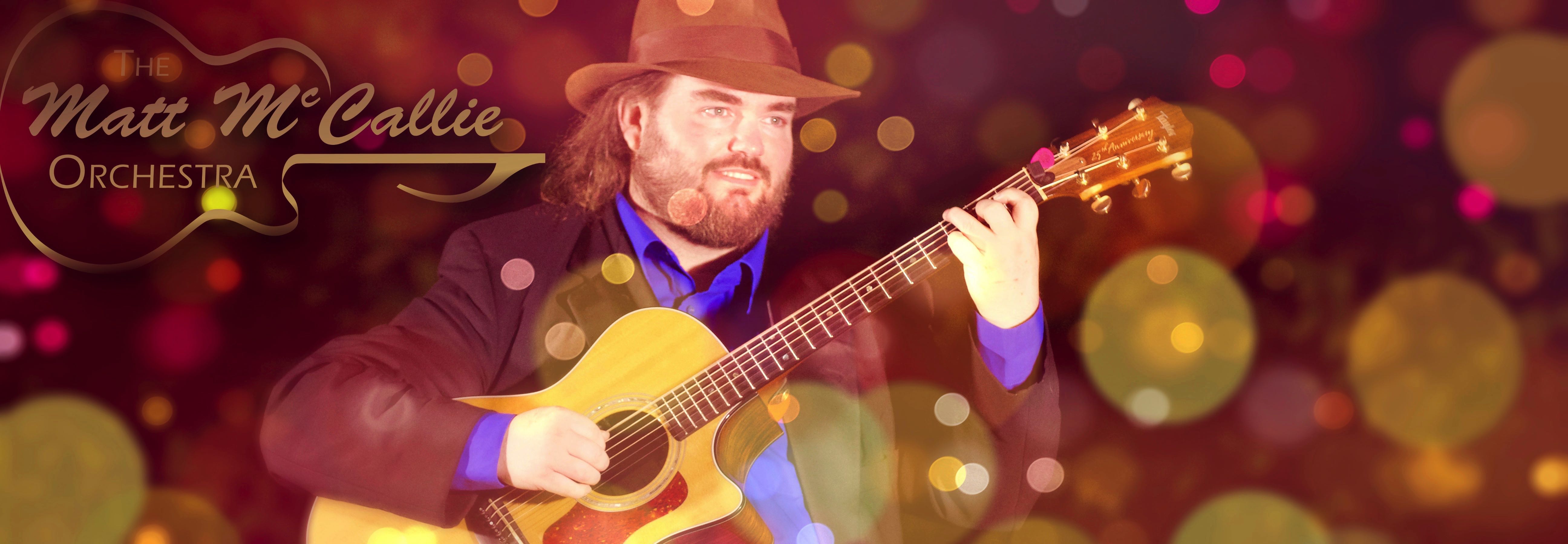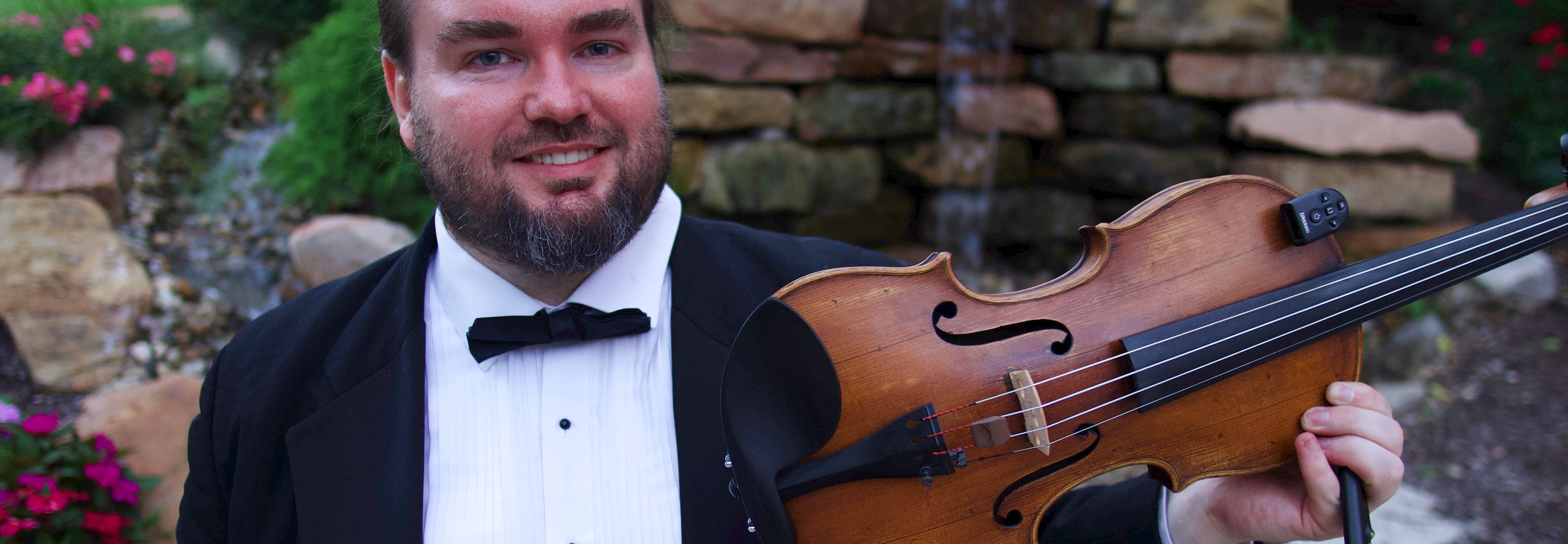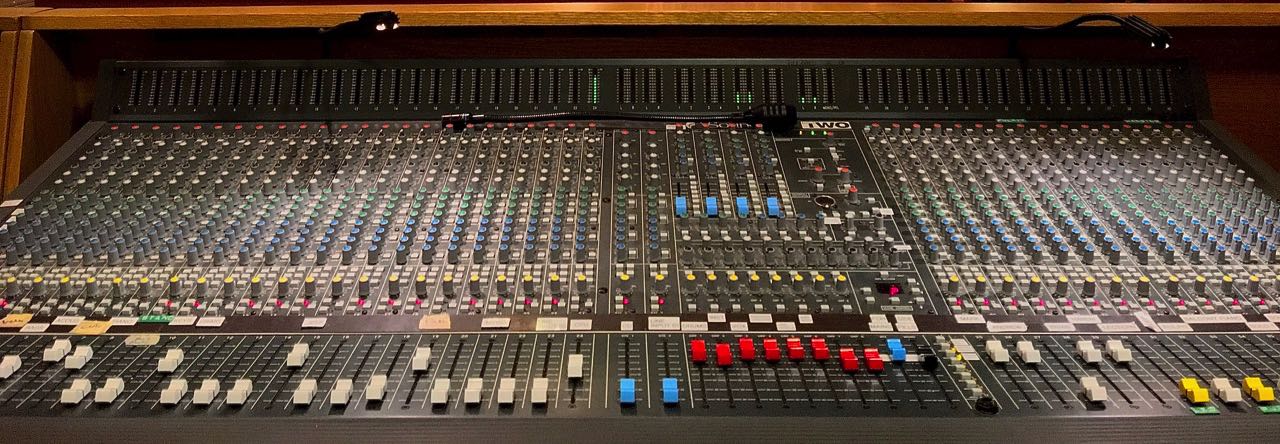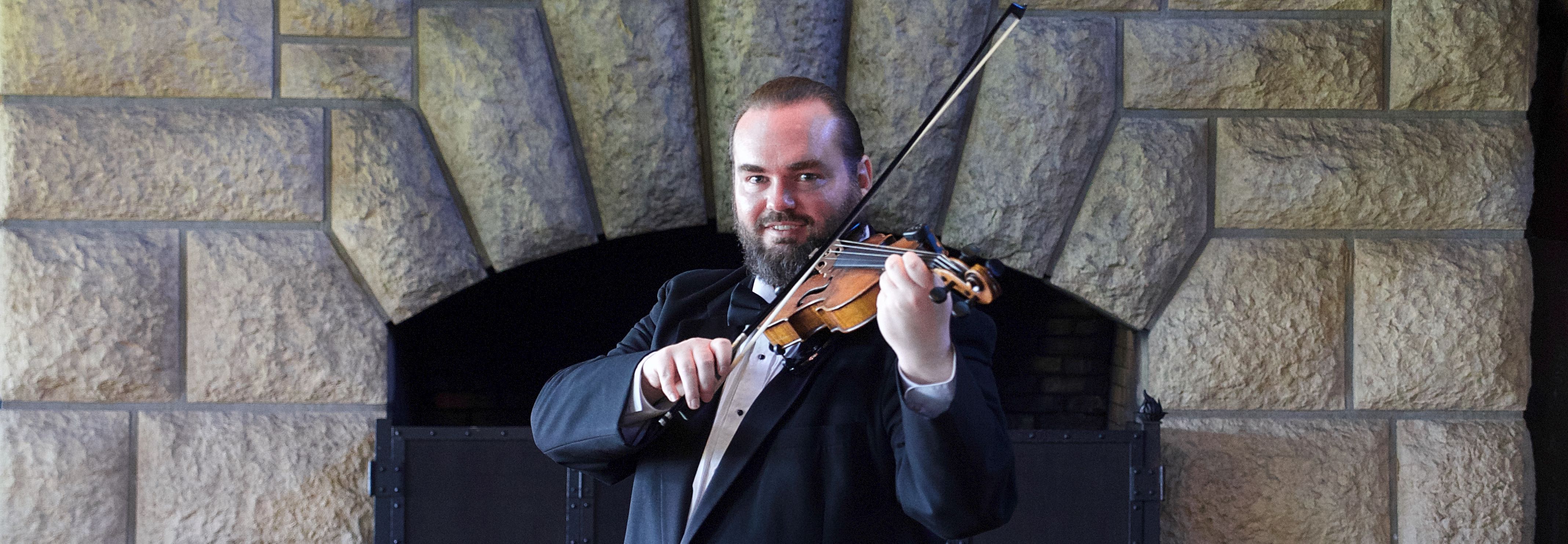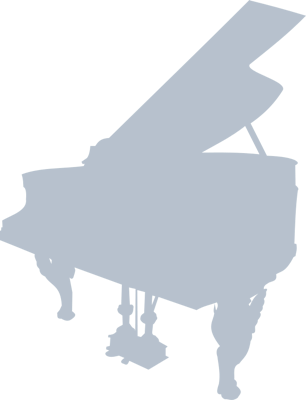
Tidbits, Trivia, & Info
A Really Big Band:
The Matt McCallie Orchestra is the second largest professional orchestra in the greater St. Louis area. The largest is the St. Louis Symphony. Most of our music is written for at least 18 musicians. Some of our music is written for over 100 musicians.
Talent:
Many of our musicians are multi-instrumentalists. For example our lead vocalist also plays guitars, keyboards, violin, drums, bass, mandolin, percussion, and other instruments. Many of our saxophone players also double on flute, clarinet, and multiple instruments within the sax family. Some of our violinists also double on viola and even auxiliary percussion.
When referring to actors and musicians it is common practice to refer to performers as the talent, regardless of whether or not they have any.
Mentors:
Many of our musicians are mentors in the community. Teaching is one of the noblest professions and we are proud to employ so many who are active in bettering the lives of America's youth. When troubled students tell us music is the only reason they show up for school, we know that what we do matters.
Accolades:
Both the wedding business and the music business can be competitive and we have the spirit, skills, and determination to be the best. The Matt McCallie Orchestra has earned national recognition ranking within the top 5% of all types of wedding vendors including other bands, florists, caterers, coordinators, venues, photographers, etc. Locally we've won the St. Louis Battle of the Bands competition where we performed covers and original music that led us to victory.
Individually, our members have also earned awards at performance competitions taking home top honors at state festivals and fairs for singing, guitar playing, and even songwriting.
Many of us also received honors in school such as being selected their high school's student leader, representing their school at statewide youth leadership events. Some developed social skills as peer conflict mediators. And we've worked hard beyond high school achieving degree's Magna Cum Laude and even maintaining a 4.0 GPA throughout graduate degree studies.
Those of us who have pursued degrees and licensure as educators have taught all ages from pre-K to graduate level courses at the university level in private and public schools. Some of us even hold licenses to teach K-12 music in as many as 4 states. And the excellence we ourselves pursued as students has been mentored to young students who have received the highest possible honors at regional and state level music competitions.
Our Impact on the St Louis Music Scene:
In 2014 The Matt McCallie Orchestra provided 120 paying jobs to musicians local to Saint Louis, Missouri. We also constantly strive to raise the bar and enhance the quality of live music in St. Louis.
Inception:
The Matt McCallie Orchestra became a licensed limited liability company in May of 2012. This band was created out of the urge of St. Louis musicians who already played in multiple big bands, community orchestras, and university ensembles who were frustrated with the lack of quality and professionalism of those other groups. St. Louis musicians were yearning for a band they could truly be proud to be part of, performing music that was challenging, fun, and most of all, a real blast for its audiences!
Qualifications:
Nearly every musician in The Matt McCallie Orchestra has earned at least one higher education degree from some of the world's most prestigious music programs. Berklee College of Music, UNCO, The University of Northern Texas, SIUE, SEMO, and St. Louis' own Webster University have all influenced our incredible sound.
Experience:
The Matt McCallie Orchestra's musicians have decades of professional performing experience. Our musicians regularly perform at wedding ceremonies, wedding receptions, corporate functions, community concerts, musicals, private parties, music festivals, birthdays, July 4th, New Year's and other types of events.
Styles:
The Matt McCallie Orchestra loves to keep things musically interesting. We perform nearly every style popular in the U.S.A. dating back centuries. We even play country and western.
Breadth:
Most bands have a repertoire of only 50-200 songs. The Matt McCallie Orchestra has been creating a most impressive library for many years and offers over 2,000 songs available for your event! And we are constantly adding new, exciting arrangements of popular favorites.
Travel:
The Matt McCallie Orchestra has concentrated most of its performances in and around the greater St. Louis, Missouri area. In recent years we have also travelled out of state multiple times to entertain events in Arkansas, Illinois, Indiana, Iowa, Kansas, and Kentucky. We hope to expand our reach across North America and eventually the world. Musicians in this band already have national and international touring experience sharing their music all over the planet.
Veterans:
We have family in the armed forces and support our troops' efforts to maintain peace. We also hire active service members and veterans.
Extra Curricular:
Our musicians are busy people but some also have hobbies and side projects. Some of our band members drive vehicles they have built themselves that can run on alternative fuels such as 100% soy bean oil, JP-8, Kerosene, and biodiesel. A lot of restorations of older vehicles dating back to the 1920's have also been performed by our crew.
We also have athletes; not just the typical U.S. sports. Fencing, archery, marksmanship, badminton, martial arts, golf, and even equestrian triple eventing competitions have made some of our members noteworthy names outside of music.
Caring for the earth is important too. We have musicians who have also designed and constructed solar and wind powered devices currently employed in agricultural and residential applications. And we have members involved in raising and breeding animals, including beef cattle with incredible stewardship to improve quality of life for every living thing under their care.
Home, Here & There Mostly:
North America is vast and our band leader has hung his hat in several states, sometimes even at multiple addresses within each state. States such as Alaska, California, Colorado, Illinois, Massachusetts, Montana, Mississippi, Missouri, and Wyoming have all been called home.
Keyboard Secret:
When we play locations that have no piano available we provide our own keyboard. Often times, the floor has a slick surface and dust from fresh foot traffic makes it impossible to grip items to the floor. Our pianist uses a foot pedal for sustain but in many scenarios has to use a heel instead of toes to depress the pedal. Otherwise the pedal will slide out of reach. So the footpedal faces the same direction as usual but our pianist has to operate it backwards.
More Instruments:
While The Matt McCallie Orchestra most often performs as a soloist up to a twenty piece orchestra, many of our arrangements are written for much larger ensembles. Some of our arrangements have over a dozen auxiliary percussion alone and parts for over one hundred musicians.
Going Wireless:
Wireless PA systems relieve the headaches of tangled wires but they present many unique problems. Wireless microphone receivers can receive competing signals and cause interruptions during a performance. The Sheldon in St. Louis, MO has experienced music playing through their sound system that is being performed blocks away at Powell Symphony Hall or The Fox Theatre.
The FCC requires that wireless microphone technicians and operators be licensed to handle many professional wireless microphone systems. Wireless transmitters send a signal that can be picked up by other nearby devices, even affecting locals watching television.
We rarely need to use a wireless microphone but when we do we have something different from what you see by most bands and venues. We use a Line 6 XD-V75. This mic has performed very well for us and has multiple advantages over other popular wireless systems.
Two things make the XD-V75 unique. First, it doesn't require a license to operate because instead of operating in frequencies that compete with other common devices, it operates on the 2.4GHz band. This is the same band used by mobile internet devices. The same way that multiple people can make individual phone calls in one location and not hear each others' conversations is how this device avoids similar interference.
But remember that with any PA equipment devices that transmit and receive any sort of wireless signal can still create signal interference with proximity that is too close. And even hard wired audio cables can be distorted with interference from other cables and electronics so make sure you iPhone is in Airplane mode when close to the band.
The other unique feature of the XD-V75 is that it has built in models of multiple popular microphones. It can digitally mimic properties of analog microphones such as the Shure SM58 and others in terms of frequency maps, feedback rejection, proximity sensitivity, and tone. It is like having several different mics in one.
American Idol brought these microphones into greater popularity by using them on the show for their performers.
Digital Music:
Since 2014 The Matt McCallie Orchestra has been transitioning to digital sheet music. The advantages are many. We have invested in used iPads on which we can load what fills a 5" binder of printed sheet music onto just a slim tablet. The transition to digital devices has saved over a thousand dollars each year in ink, paper, and binders.
An Axe for Every Occasion:
On most of our larger gigs our guitar player brings three guitars; an acoustic, hollow body, and a solid body electric. Each guitar has a very unique tone and feel when played.
The acoustic is mostly used on pop, folk, country, and a few big band arrangements. The hollow body is what is often referred to as a jazz guitar, which is it's main purpose though it is also preferred for some funk, Motown, Rockabilly, and other styles as well. The solid body electric is used on pop that needs a clean tone, some jazz, and most of our rock that requires distortion. All three guitars are electrified with built in pickups so they can run directly through any sound system without requiring a microphone or a DI.
What Key Is It in?:
Guitar players have it easy for the most part when it comes to transposing into different key signatures. Most electric and jazz guitar players never use a capo because they are usually playing single note melodies or chord shapes that move all over the neck.
In bluegrass, musicians will ask what key a song is in and someone will say capo three. While perhaps many musicians don't know what key they are actually playing in, a capo isn't just used to change keys while maintaining more familiar or easier to play chord shapes.
A capo can enable a guitar player to play in a way they would otherwise be unable to, particularly when playing a finger style that incorporates an alternating bass, mid range harmony, and a high pitched melody all at once. Some of the musicians well known for their use of a capo to attain their unique finger style sound include James Taylor, Peter, Paul, & Mary, and John Denver.
Transposing Instruments:
Not every instrument can simply read the music of another instrument. That's because many instruments read in different keys, even if they share the same clef. For example, tenor saxophones and trumpets read in Bb treble clef. Alto saxophones read in Eb. Viola uses an alto clef.
Even guitar is a transposed instrument sounding an octave lower than what is written. Guitar is actually supposed to be written across two staves in bass and treble clefs like piano, but was transposed up to treble clef to save money when printing music. Even bass is a transposed instrument.
Stage Monitors:
Monitors have nothing to do with visuals for musicians. On stage, a monitor is a speaker that is pointed toward the musicians so they can hear themselves and other parts of the band. Without monitors it is sometimes impossible to hear from on stage during a performance. Musicians need to hear themselves and each other to know where everyone is metrically in the music and for intonation.
Large bands like ours often need at least three monitors. One is needed for the vocalist at the guitars and another for the vocalist by the piano. Bass and drums often need their own monitor as well since they are usually placed behind every other instrument. String players also usually need a monitor when playing with a band because they are so quiet they cannot hear themselves over drums and horns.
Studio Monitors:
Indeed, musicians use another type of monitors. Recording studios usually have at least two rooms. One called the control room, the other the live room. The live room is where the artists perform. There may be isolated booths in and adjacent to the live room. The control room is where the engineer works.
Similarly to on stage monitors, studio monitors are for the musicians, producers, and engineers to listen to what the artists have performed. The most common type of studio monitor is called a flat response nearfield monitor. It is designed to be listened to at close proximity, a distance of three to four feet from the engineer's ears. And they should be mounted as close to ear level as possible, both pointed straight toward each ear.
Flat response means that instead of trying to sound good by boosting certain frequencies they are designed to sound as accurate and true to the original sound as possible. Your favorite CDs sound great on so many different sets of speakers like in your car, your home stereo, your iPhone, etc., because they were mixed and mastered on speakers that have the influences required to sound good in each of those environments removed.
The industry standard volume level for nearfield monitors is 85 dB. This level will cause permanent hearing damage at extended lengths but engineers usually listen to brief sections of a song at a time and often only certain instruments together as they fine tune the recordings.
Emcee:
You've heard it and seen it as M.C. and emcee. What does it mean? It stands for master of ceremonies, which is the title of the person who hosts an engagement, making all of the announcements to the audience. Make sure you give your M.C. as much detail as possible well in advance, including phonetic spellings of any names that might be easily mispronounced.
Aisle to Isle:
A common typo is between two words that sound the same but are spelled differently with separate meanings. If you are planning a wedding, you will probably walk the aisle before you honeymoon on an isle. We would be delighted to perform your processional music as you walk the aisle on an isle at your destination wedding!
Pro EQ Tip:
One of the reasons The Matt McCallie Orchestra literally sounds so much better than other bands is that we use top quality sound equipment. One of our secret weapons is our Allen & Heath Mix Wizard that has something most mixers don't; it has sweepable mids. That means it can do more fine tuning of mid range frequencies. Mids provide a lot of strength and clarity in an audio signal but can easily overwhelm lows and highs and create an overall dull sound. We literally have more control over our sound than most.
Feedback Buster:
Acoustic guitars have a large, open body designed to resonate and project outwards via the soundhole. For acoustic guitars with an internal pickup, sometimes too much sound can actually come into the soundhole when on stage playing through a sound system.
For decades musicians have relied on monitors on stage, usually placed on the floor of the stage in front of them so that they can hear their quiet acoustic instruments when sharing the stage with loud instruments like drums and horns. Since stage monitors are essentially speakers pointed at the musicians instead of the audience, there can be feedback from microphones and acoustic instruments with pickups.
Most live acoustic guitar players have a pickup inside of their instrument allowing them to provide the soundboard with a strong, loud signal that the audience will be able to hear clearly in the house mix. Monitors can create feedback, particularly with acoustic guitars due to their large resonance chamber from which the internal pickup is gathering its signal, even if there is just a bridge mounted pickup.
Acoustic guitars have a very simple solution available to reduce feedback by using a feedback buster. The device is incredibly simple and affordable. It is simple a piece of rubber that inserts under the strings and covers the soundhole. You would not want to use an external microphone to amplify a guitar wearing a feedback buster because the device is muting the acoustic projection of the guitar.
Band Seating:
When tallying how many chairs will be needed at your event make certain the musicians will have armless chairs. Instruments like guitar, drums, saxophones, and strings will be unable to play in armed chairs because the arms will interfere when playing their instruments.
Rock Stop or Strap:
Ever wonder how a cellist is able to hold onto such a large instrument without it slipping and falling to the floor? They use a rock stop that is like a grippy hockey puck on the bottom and on the top is concave to receive the end pin. On some surfaces a rock stop won't suffice so a strap can be used instead that hooks to the bottom of a chair leg at one end, and catches the end pin at the other. In desperate situations when neither is available a little ingenuity can save the day. A rubber soled shoe turned around can function as a makeshift rock stop.
That Plucky Sound:
That plucky sound strings make when they pluck the strings of the instrument is called pizzicato.
Mutes:
Mutes are common for violins, violas, cellos, and upright basses. They are also used by brass musicians. There are different types of mutes for different effects. Nearly every type of mute makes the instrument a little quieter because the sound is dampened. Sometimes this is the purpose and those mutes are often referred to as practice mutes. But many mutes are selected for their unique ways of coloring tone.
Trumpets and trombones usually carry the same types of mutes. Most popular in big band music are cup, straight, plunger, bucket, and harmon mutes. Every individual mute can sound as unique as the instruments themselves. Some can be modified and altered to effect different sounds. For example, a common wah-wah sound is when a plunger is transitioned from closed to open while the instrument is being played. Horn players can also improvise by using their hand to cover the bell of the instrument in place of a mute, though with limited results.
Who Has the Throne?:
The drummer. Drum set musicians do not sit in a regular chair or a bench like a pianist. They use a stool that provides them the mobility they need to play the many drums in their kit. The drummer's chair is called the throne.
Bring Your Own Rug:
Drummers almost always travel with their own rug or piece of carpet. They literally bang on their instruments, which can make them slide even on carpeted surfaces. An extra rug helps keep the drums from moving while being played. It also protects the floor from becoming scuffed.
Keyboard vs Piano:
An acoustic piano undoubtedly adds an authentic sense of class, especially a grand piano. But pianos are very difficult to move and easily lose intonation from nearby doors opening and closing, ventilation systems, and inevitably just from being played.
A keyboard is a solution in many ways. Some smaller ones can be battery powered with internal speakers making them ultra flexible. But most professional keyboards are still large and heavy and require a separate amp our sound system to be heard, as well as a power supply needed for each piece of equipment.
While it is rare to find a keyboard that can convincingly mimic the sound of an acoustic piano, they usually come with a plethora of other sounds. Some of the most popular instruments a keyboard can imitate include the Fender Rhodes, Wurlitzer, Hammond organ, clavichord, and synthesizers.
Most keyboards also have patches that mix multiple instrument sounds together such as a kick drum and snare, strings and piano, or a horn section. We wholeheartedly recommend hiring actual instrumentalists instead of having a keyboard player imitate real instruments. Not only because they usually sound cheesy, but because it is physically impossible for a keyboard player to play all of the different instrument sounds and their individual parts simultaneously in real time. There is absolutely no comparison to a real big band or orchestra.
Mp3:
An mp3 is a digital coding format for audio files. It is not a lossless format. This means any time you purchase or convert a song as an mp3 it is losing the majority of its quality. An mp3 is a fraction of the quality of its CD version, which is already limited compared to a live performance. The use of mp3 files should be avoided for public events in favor of CDs or vinyl for recorded music.
Old-Time:
Pronounced old-timey, old-time music is an actual style with its heritage spawning primarily from the Southern Appalachian mountains. It is traditionally played on acoustic instruments and to the untrained ear will sound a lot like bluegrass, folk, sea shanty, or square dane music.
The music often as A, B, and sometimes a C section with primes as options. Sections of the music are often repeat giving opportunities for different musicians to take turns playing the melody and some opportunities for improvised solos. The melodies are usually fast paced with strong rhythmic pulsing and can sound modal over the harmonic structure.
Instrumentations usually include banjo, harmonica, fiddle, acoustic guitar, upright bass, mandolin, concertina, accordion, or other chordal and melodic stringed instruments but are usually limited to smaller sized ensembles.
Chords & Cords:
These two terms and spellings are some of the most misused and confused in the musical lexicon. A chord is when multiple pitches are played simultaneously. The intervalic nature of the two notes in respect to their placement within a melodic and harmonic structure, as well as the key signature determine their identity.
In most basic western harmony a chord is built upon a triad using a root, third, and fifth. These notes can be inverted and changing one pitch can either change the chord to an inversion of a different chord or create musical tension called a suspension or a chord with the same root but spread differently like a six chord.
Pitches added to a basic triad expand the chord with extensions creating new harmonic values such as a seventh, ninth, eleventh, and thirteen chord. These numbers represent the interval of the notes from the chord's root. Determining whether or not some of these voicings are truly for example, a thirteen chord can be challenging, particularly when looking at the voicings on a single instrument.
A perfect example of when a harmonic analysis can be challenging is when playing a thirteen chord on a guitar. A guitar has only six strings, meaning you are limited to playing just six notes at once. And if you are thinking a twelve string can play more notes, the extra strings are the same pitches at octaves and playing the same notes again at an octave does not qualify them as a new addition in a chord's analysis.
A thirteen chord is such because it is built on the structure of a root, third, fifth, seventh, ninth, eleventh, and thirteenth. This is one note more than a guitar can play simultaneously, and even playing six different pitches is challenging due to the unique layout of the notes on a guitar.
In such cases it may be necessary to analyze the notes being played by other instruments in a song to know the chord being played at a given moment. If, for example you can identify a root, third, and thirteenth that chord could actually be a six chord instead of a thirteenth. If a seventh, ninth, or eleventh is present you are probably playing a thirteen chord, but it could still be something else if it is an inversion or even a polychord.
Chords get more complex. Every note beyond the root can be raised or lowered to make them minor, major, augmented, half diminished, or fully diminished. They come in various combinations that change how the music will sound. For example a major-minor chord, commonly referred to as a dominant chord can sound different by adding other notes for something like a #9, b11.
Singers and those discussing vocalization often mistakenly refer to their vocal folds as vocal chords. It is a rare talent who can consistently sing multiple notes simultaneously with any degree of emotional expression and clear communication. Vocal folds are vocal cords, not chords.
Cords are also an alternate word for rope like objects. Musicians use cords to connect their guitar, bass, and piano into an amp. Electrical cords come with most home appliances to supply to electronic devices. When being analytically specific I like to think of vocal cords as the edges of the two folds that contact when adducted.
Frequency Notching:
This is a technique used by all audio engineers. There is an old school saying that one should never boost the frequencies of any source in a recording. Instead of boosting, frequency notching decreases frequencies from each instrument's track until the most important tracks sound their best.
In certain situations, particularly when a band performs live, it is impossible to boost some frequencies; particularly high end frequencies because feedback will occur too easily. Otherwise, most modern engineers boost and cut as needed.
Tessitura:
Tessitura is the range of pitch from the highest to the lowest. For example a song may have a tessitura of three octaves from the lowest note a given instrument plays up to the highest, in that song.
Singers are often credited on their abilities by their range. But rarely does a vocal part in any style of music exceed three octaves. Singers with five octave ranges don't have a lot of repertoire to show off their abilities. Frank Sinatra rarely sang music with more than a one octave tessitura.
Drum Key:
Even drums have to play in tune. On a drum set each shelled drum can have its pitch raised or lowered by tightening or loosening the head. Most drummers tune them to actual pitches. The same is true for congas and bongos. They all use a special drum key for tuning pitch.
Timpani Pedals:
Timpanists play using mallets. What you usually can't see while their performing is that they also use their foot. Their foot adjusts a pedal at the bottom on each drum to change pitch throughout each piece of music.
Modern timpanists are increasingly using a tuning gauge that indicates where the pedal should be positioned for each desired pitch. Because the drums vibrate and move so much while literally being banged on the gauges have to be reset frequently.
Because it is time consuming and a bit of guess work for a timpanist to quickly change pitches during a song most will usually have multiple drums each tuned to different pitches.
Piano Percussion:
Piano is generally considered part of the rhythm section in contemporary music but in classical music the piano is categorized as percussion. This is because when a key is depressed a string is struck, similarly to other percussion instruments instead of being plucked or bowed like in the strings sections.
Harp:
Harp is a commonly mistaken name. There are multiple types of harp like the celtic harp, which uses levers operated by hand, and the larger pedal harp where accidentals are changed by the musician's feet. In America, there is also the juice harp and many call a harmonica a harp, even though it is exclusively a wind instrument.
Like piano, harp reads in two staves using treble and bass clef but the fingerings are different using the thumb and the next three fingers to pluck the strings without engaging the pinky. Using one less finger per hand makes using a harp to play piano parts difficult.
Backline:
A backline refers to amplification used by a band. When a backline is in place the speakers, amps, and cabinets are permanently setup at the back of the stage so musicians don't have to bring their own, they can just setup their instruments and plug in.
Some clubs offer a backline with more than just amplification. Some include a drumset, piano, and possibly auxiliary percussion. Most clubs also have their own stage lighting as part of their backline. The more backline available, the less work for the band. If a band has roadies, the band can usually save money not needing to hire as many roadies, or for fewer hours.
Sound Guy:
Most gatherings that have live entertainment require amplification. A dinner can be very noisy with wait staff navigating the crowd, clanking silverware and dishes, and guests talking over the noise. A small crowd of 50-100 people can overwhelm an acoustic violin, guitar, singer, even a piano. If the venue has reflective surfaces without acoustic treatment a dining or reception hall can sound like a gymnasium.
When bands entertain a venue such as a sports bar or a night club there is usually a backline in place, at least in venues that frequently host live entertainment. The band will likely plug in to the equipment on stage but it is challenging to create a mix that helps the musicians hear themselves well on stage through monitors and simultaneously a separate mix that sounds good in the audience.
This is where having a dedicated sound guy comes in handy. Most venues have a sound guy available and probably won't let you bring someone of your own. The catch however, is that the bar or club is usually the one hiring the sound guy but they often pass that expense along to the band. Quite often the fee for a venue's sound guy will cost more than what the entire band makes in a night. In small bars and clubs you can usually bet that a sound guy is making more than any individual musician on stage, and maybe more than the entire band will collectively earn.
Having a sound guy or gal can make or break how a band sounds. Bands that frequently play different venues are less likely to have a dedicated sound guy, which may have some advantages but always adds more work and pressure on the band to manage their sound on stage and for the audience. Whether or not a sound guy is present it is always essential to allow the musicians to perform a full soundcheck before their performance begins.
DMX:
Not talking about a rap artist. DMX is what the controllers are called for stage and effects lighting. Most PAR, gobo, laser, uplighting, washes, and other types of lighting used for entertainment purposes are compatible with DMX controllers.
DMX is short for Digital Multiplex. Most DMX512 compatible lights have male and female ports, allowing the lights to be connected to a controller and to each other. Lights can be daisy chained so they will mimic the other lights in their chain so that they all change colors or patterns coordinated in the same way, at the same time.
They can also be controlled individually with a board similar to a mixing board used by musicians in live and studio applications. Each light can be on its own channel with knobs and switches that activate each light's various features. Controlling all of the lights with a DMX board gives the user the most capability. DMX has been used for decades and is compatible with older halogen style bules as well as modern LEDs.
Copy:
Text published and read is referred to as copy. For example when a business places an ad in a magazine the text they submit is referred to as copy.
In the fall of 2019 The Matt McCallie Orchestra began working with a new band roadie. His name is Munchkin and he is an Alaskan Malamute. Munchkin didn't start working any sooner because he was a still growing little puppy. Now that he is big and strong he works as a federally registered service dog helping one of our disabled musicians by carrying some of the heavy gear. Munchkin's assistance not only lightens the load, he helps reduce the number of trips between the truck to the stage. He now has his own webpage.






